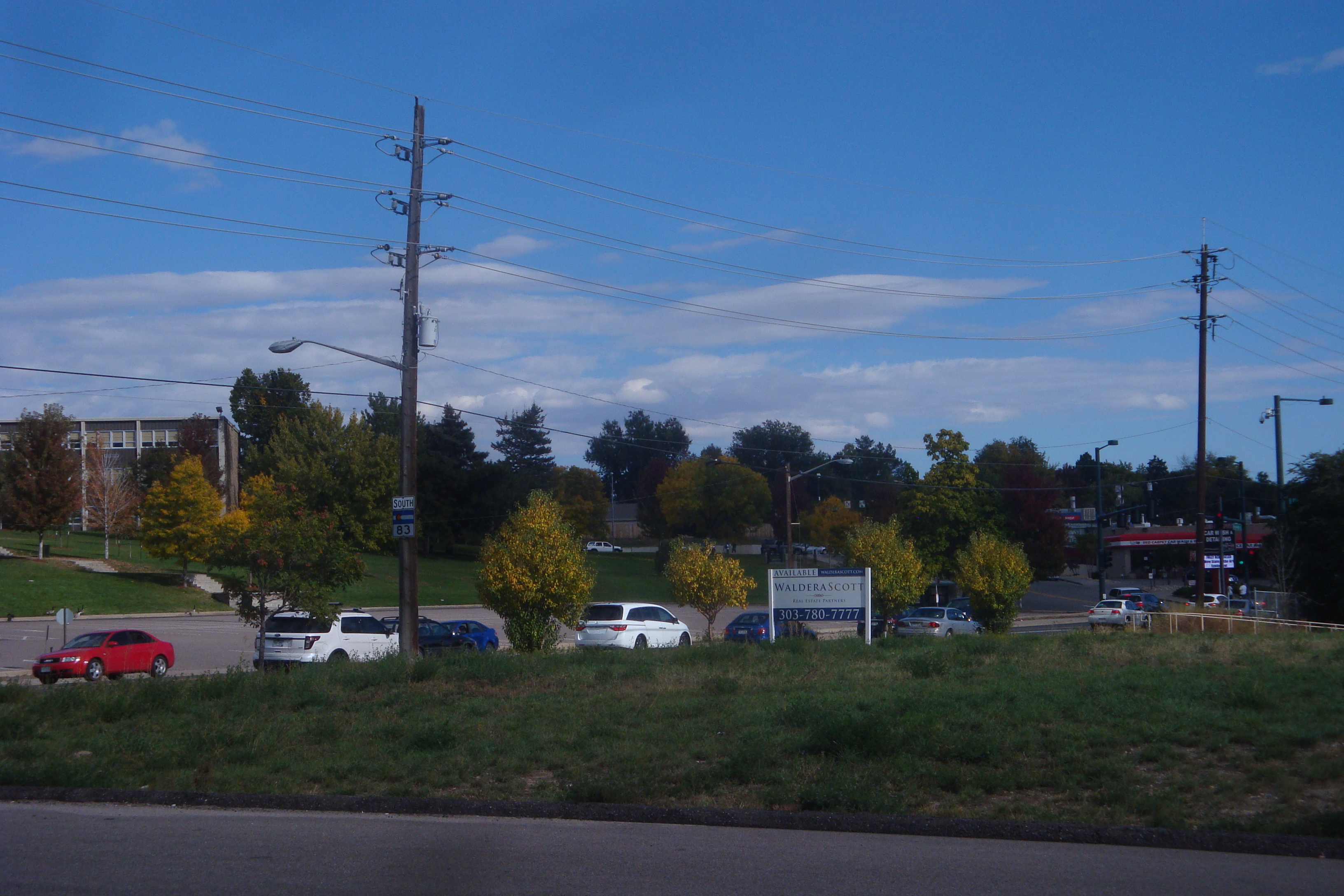
by Mark Smiley | Oct 24, 2014 | Main Articles
by Glen Richardson
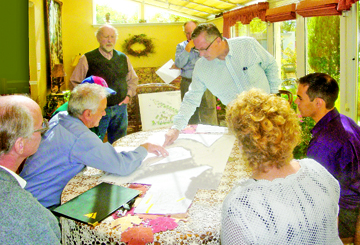 For families living in the Virginia Vale and Hilltop neighborhoods it’s a nightmarish flashback to a development scheme that dates back more than 50 years. It involves a three-acre plot of land along Leetsdale Drive directly across the street from George Washington High School where developer Paul Naftel of Emerald Properties LLC is now proposing a Jimmy John’s be built where years earlier he proposed a McDonald’s.
For families living in the Virginia Vale and Hilltop neighborhoods it’s a nightmarish flashback to a development scheme that dates back more than 50 years. It involves a three-acre plot of land along Leetsdale Drive directly across the street from George Washington High School where developer Paul Naftel of Emerald Properties LLC is now proposing a Jimmy John’s be built where years earlier he proposed a McDonald’s.
Saga of the disputed property goes back to the 1950s when development of the southeast Denver neighborhood was just beginning. Back then neighbors say many Denver high schools had small parks across the street — a legacy of Mayor Robert Speer’s City Beautiful campaign — and it was speculated then that the property was intended as a park.
In the 1950s Denver Public Schools founded KRMA as an educational TV station. By 1987 the station and the school district ended their affiliation and as part of that transaction the three acres along Leetsdale was given to the station. Almost immediately the station wound up in a dispute with the local neighborhoods when it won approval for rezoning, and the developer proposed a McDonald’s on the site.
Deal Stopped Earlier
Ironically back then angry residents in Virginia Vale, led by President Deb Ward, blocked the development. Paradoxically, a realtor named Paul Aceto, who now purports he is President of the Virginia Vale Community Assn., signed off with the Planning Board on the latest plan. Aceto posted a small sign at McMeen Elementary School six days prior to scheduling a meeting and used a five-year-old email database to send announcements. He hasn’t, however, provided minutes or attendance information. Aceto says the previous Virginia Vale board and the current vice president extended the presidency of the neighborhood group to him in 2008. Nevertheless, several alarmed Virginia Vale residents testified against the plan at a hearing before the Planning Board in the Webb Municipal Bldg. on Sept. 3.
“I am disgusted by the lack of notice to anyone in our neighborhood regarding this re-zoning. I only became aware of it when I happened to see the small notice posted two weeks ago. No one on our own or adjacent streets were previously notified,” Holly Brooks told City Planners. “Seven years ago many of us and our neighbors spent nearly a year in meeting rooms crowded to standing room only to reach a compromise with the same developer on use, lighting, landscaping and barriers protective of our neighborhood,” she recalled. “The developer’s latest proposal is everything we fought against last time, fast-food,” she angrily retorted.
Aceto told the Chronicle at press time that “in lieu of the potentially serious consequences now apparent, the Virginia Vale Community Association is taking a different position on the development and sending a letter to Kyle Dalton at the Planning Board revealing the group is altering its support.” At the Oct. 15 City Council Meeting, however, Senior Planner Kyle Dalton told Council members and attendees that the VVCA by no means rescinded their approval. Rather, that he received a letter that said some of the people in our neighborhood had surfaced opposing the plan.
Ward Speaks Up
Former President Ward, who still lives in Virginia Vale but is no longer affiliated with the Community Association, tells the Chronicle that when Naftel originally tried to develop the triangular Leetsdale property, “we refused to allow a mixed use zone, only allowing a very specific PUD, which is why he is having to jump through hoops once again.” She recalls that Naftel’s spokesperson made it sound as if the community association was accepting rezoning at that time. “We most definitely were not,” she declares.
The spunky Ward also says, “I would think that it would benefit all neighborhoods with these little odd bits of open land to not allow mixed usages, but stick with PUDs so that neighborhoods can maintain some control of what they will accept. Once a mixed use is allowed — especially the broader zones — I believe neighborhoods lose control for good,” she warns.
The latest redevelopment plan also caught the attention of Reuben Drebenstedt, President of the South Hilltop Neighborhood Assn. Because of interest and concerns by Hilltop neighbors regarding the proposed zoning and development plans for the property he scheduled a meeting on Oct. 13 to discuss the proposal with the owner-developer and his architect.
Traffic Concerns
Drebenstedt expressed neighborhood concerns about high traffic on and off of Exposition and into adjacent neighborhoods. “School kids crossing Leetsdale through traffic, not using crosswalks; it will be a danger to them and autos,” he said. Drebenstedt also suggested too many businesses are being located on the small plot. A total of four spaces — the largest being 2,400 sq. ft. — are proposed on the property. Several attendees at the Hilltop meeting also articulated concerns that there would be a sharp increase of parked cars on Exposition plus increased loitering. At the South Hilltop meeting developer Naftel indicated a willingness to consider the options being suggested at the meeting. Nevertheless his architect Michael Rudd, who also attended the meeting, expressed doubt the City would give approval.
Given that the current Mayor and city staff generally support developments rather than parks, it’s not surprising that the Planning Board staff recommended approval (only changing the PUD from 584 to PUD-G 10). Senior City Planner Kyle A. Dalton wrote, “The land or its surrounding environs has changed or is changing to such a degree that it is in the public interest to encourage a redevelopment of the area or to recognize the changed character of the area.”
Changes identified in the surrounding area by the developer’s application include the redevelopment of Lowry, suggesting it created an increased demand for neighborhood commercial service uses, such as retail and restaurant. “Since the time of the previous PUD adoption, a mini-storage facility has been built, development trends have changed, and a new zoning code has been adopted,” the application states. Virginia Vale resident John Sturtz notes that despite Planner Dalton’s support of the developer’s argument that business in Lowry is reflective of the Leetsdale project, “it is blocks away and doesn’t reflect either this community, the environment around George Washington High School or our traffic issues.”
The Denver City Council is tentatively scheduled to vote on the proposed development November 17.

by Mark Smiley | Oct 24, 2014 | Main Articles
Merchants Suffer From Construction, Traffic And Parking Woes;
Will There Be Healing During The Holidays?
by Phil Kummer
Delirious development plus the University-Josephine storm sewer system and street project through Cherry Creek are aimed at creating a rebirth of this upscale area. Yet after suffering through nearly a year of parking and traffic turmoil plus shopping setbacks there are a few signs of healing as the holiday season draws near.
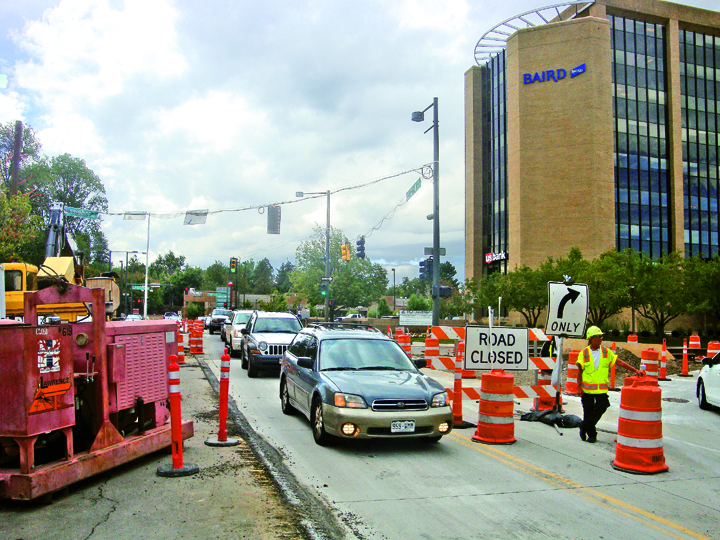 Furthermore, the half-built building boom has businesses seeing mounting monetary scars while some have abandoned the area altogether. “Often it has been easier to spot cranes soaring overhead than shoppers on the streets and in stores,” said Beth Saper of Little Feet, the family-owned footwear fashions store for kids located in The Plaza at Cherry Creek on the west side of University Blvd. Many local businesses have been impacted and the rippling effect goes beyond the area bounded by 1st and 3rd Avenues and University to Steele Streets or the Cherry Creek Shopping Center.
Furthermore, the half-built building boom has businesses seeing mounting monetary scars while some have abandoned the area altogether. “Often it has been easier to spot cranes soaring overhead than shoppers on the streets and in stores,” said Beth Saper of Little Feet, the family-owned footwear fashions store for kids located in The Plaza at Cherry Creek on the west side of University Blvd. Many local businesses have been impacted and the rippling effect goes beyond the area bounded by 1st and 3rd Avenues and University to Steele Streets or the Cherry Creek Shopping Center.
Hayley Morris, store manager of Ten Thousand Villages — a national non-profit that promotes artisans from around the world — says that construction has impacted sales. “Foot traffic, which is critical to the store, is down 25 percent compared to before construction,” she reveals. Due to the resulting loss of business the store, located on 3rd Ave. next to the 250 Columbine construction project, has increased store hours is are now open on Sunday. They also organized a fundraiser — Art for Artisans — to recoup some of the lost revenue from previous months. Hayley is hopeful nonetheless that during November and December customers will return for the holiday shopping.
Busting Business
The Cherry Creek Whole Foods store sandwiched between the University-Josephine projects began feeling the effects last February. Due to a dramatic revenue drop, 50 employees were transferred to other stores or in some cases chose to leave the company. Sharon Wilkinson, the store’s Greater Denver Area Marketing Team Leader, gives the Cherry Creek North Business Improvement District high marks for setting up meetings with the city and in particular with Mayor Michael Hancock at the beginning of the infrastructure project. Those meetings resulted in certain noise restrictions being lifted to allow for a quicker construction pace. Even so, the length of the project and the decline in sales has been tough on Whole Foods.
The ongoing construction has not only had an impact on businesses within Cherry Creek North and at the Shopping Center, but extends to small businesses along 6th Ave. Arv Singh, owner of the 7-Eleven convenience store at 6th Ave. and Columbine, has noticed a drop of perhaps 22 percent in revenue. Singh is making every effort to retain his nine employees. “We’re giving supplementary employee training plus doubling our marketing effort to realize the most business from each customer visit.” He nonetheless thinks about how the City might have been of more help to the small business owner, possibly with bridge loans or a tax forgiveness program.
Mathnasium, a math tutoring business also located on 6th Ave., has seen revenues shrink more than 20 percent in the past few months. Owner Bernard Doughit echoes Arv Singh, speculating that the city could have reached out to small businesses that don’t have the resources of large corporations.
Happy Holidays?
Since the 1950s the intersection of First Ave. and University Blvd. has been the foremost roadway into this premier shopping district. The biggest roadway closure ever attempted by the City shut down the intersection for 60 hours from Sept. 20 at 7 p.m. until reopening on Sept. 23 at 7 a.m. The closure brought business in the district to a screeching halt and created colossal traffic jams. Little Feet’s Beth Saper said the mayor and City held a meeting with storeowners prior to the shutdown promising a marketing plan. However, she quickly adds, “There was never any follow-through whatsoever.”
The closure, approved by Mayor Hancock, was an attempt to accelerate the paving of the intersection and move up the overall project reconstruct by 24 days. Furthermore the Public Works’ University-Josephine storm sewer project jumped ahead of schedule by three weeks, “We’ve definitely seen increased traffic to our store since the partial reopening of the roadway in October,” Saper reports. The goal of the shutdown was to allow an early start to Cherry Creek’s holiday shopping season. In late October area businesses were still holding their breath, hoping the project will be completed by the projected completion date of Nov. 1.
Even if the First Ave. and University project is fully completed in time to save Christmas, neither businesses nor shoppers can look in their rearview mirrors. Fact is the hefty rebuild of Cherry Creek North has only just begun. By the time the block-long 250 Columbine project is finished next year, across the street the seven-story, 150 room luxury hotel at 245 Columbine will just be getting underway.
Makeover Madness
The intersection of First Ave. and Steele St. is going through an equally implausible makeover. On the same corner as the 1st and Steele Apartments, there are two other major projects currently under construction: 12-story apartment building, the Steele Creek Apartments, and an 8-story office building, 100 Saint Paul. That’s 149,000 square feet of new office space and 435 residential units being added to just one intersection. Ground has just recently been broken for the Steele Creek Apartments.
Finally, mid-next year when the work is completed in front of the Cherry Creek Shopping Center, the gateway to Cherry Creek North — Clayton Lane — may again endure redevelopment. As reported by the Chronicle last month, the owner of 7.7 acres of the development site is considering redevelopment options and hired the original architect — David Tryba — to consider development options. The project is generally between East 1st and 2nd Avenues, Detroit and Josephine St.
What is impressive about Cherry Creek small businesses that have so far survived is their determination to reach out to customers in creative ways and to not give up even when the cards seem stacked against them. So when stuck in traffic or you can’t find a parking space and are ready to scream, remember that retailers in the area are feeling the pain even more. These merchants have nowhere to turn and are doing everything they can with hopes of eventually enjoying the improvements that are causing their distress.
What the future holds for Cherry Creek retailers is a matter of debate. Some store owners are hoping that the significant number of upscale apartment buildings and other new developments will result in a large client base to shop and eat in Cherry Creek. Others fear that the lack of any traffic planning or improvements coupled with a minimum number of parking spaces required by the city for the new developments will destroy the area as a retail destination for those who do not live or work in Cherry Creek.
For many of the smaller retailers they are just hoping a successful Christmas season will allow them to survive after a year of constant challenges caused them by the city and by what they view as a chaotic and haphazard planning and development process for the area.

by Mark Smiley | Sep 29, 2014 | Main Articles
Frontier Renewal Will Finish Environmental Cleanup And Prepare The Site For Development
by Mark Smiley
 Denver-based Frontier Renewal closed on September 12, 2014, on the purchase of over 41 acres at the site of the former Gates Rubber Plant in Denver. The plant has been closed since 1991 with buildings on site ranging in date from 1918 through the 1950s. Frontier Renewal will finish the remediation and cleanup work, as well as prepare the site for vertical development.
Denver-based Frontier Renewal closed on September 12, 2014, on the purchase of over 41 acres at the site of the former Gates Rubber Plant in Denver. The plant has been closed since 1991 with buildings on site ranging in date from 1918 through the 1950s. Frontier Renewal will finish the remediation and cleanup work, as well as prepare the site for vertical development.
The Gates site includes three land parcels: the Broadway Parcel is 15.2 acres between the I-25 and Broadway light rail station and Mississippi along the west side of Broadway. The Santa Fe Parcel is 24 acres between I-25 and Mississippi Ave. along the east side of Santa Fe. The Vanderbilt Park Parcel is 2.5 acres between Tennessee and Vanderbilt Park along the west side of Santa Fe.
On October 1, 1911, Charles Gates Sr. purchased the Colorado Tire and Leather Company located in Denver, Colorado, beside the South Platte River. He paid $3,500 for a property that would one day become one of the world’s largest manufacturers of power transmission belts and a leader in hydraulic and fluid power products for industrial and automotive products. In 1919, the International Rubber Company changed its name to the Gates Rubber Company, and operated at the site from 1937 through 1991.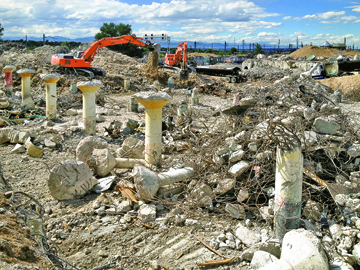
While at first a small enterprise producing “durable treads” made of leather intended to extend the life of the average automobile tire, the company quickly grew and in 1914 produced its first rubber tread. The growth that followed necessitated a new facility and the site at 999 S. Broadway was selected because of its relative proximity to downtown and because it was adjacent to the streetcar line and the railroad tracks, essential for the national distribution of Gates’ products. At the time south Broadway was still a dirt road and considered “suburban.” In the following five years the company added a warehouse, machine shop and more factory space. Growth continued through nearly the rest of the century, with increasing focus on international expansion. In 1995 the era of family-ownership ended when Gates became a wholly-owned subsidiary of Tompkins PLC, a London-based firm. While manufacturing no longer takes place in Denver, Gates continues to operate with its corporate headquarters in Lower Downtown.
In 2001, Cherokee Denver purchased the south Broadway property and created plans for mixed-use development. Cherokee investigated whether some preservation could be accomplished, but due to the unusual circumstances of the contamination, preservation was never guaranteed or promised. Ultimately the Denver City Council-approved General Development Plan did not include preservation elements, and in the aftermath of the 2008 economic crisis the Cherokee deal died and Gates reacquired the site.
Three years later, in 2012, Gates secured Certificates of Non-Historic Status, which are precursors to demolition permits. After months of controversy, a Denver City Council subcommittee voted, in September 2012, to halt efforts to consider the crumbing manufacturing plant one of the city’s historic landmarks. This action was despite a University of Colorado Boulder student asking the city to consider the buildings historic, a designation that would have prevented demolition.
In 2012, Eugene Elliott, presented the Denver Landmark Preservation Commission with a non-owner application and $250 filing fee to grant landmark status to the three oldest remaining structures: the manufacturing plant, known as Unit 10, plus the power plant and warehouse to the north of it. “The former Gates Rubber Company is a huge piece of Colorado and, more relevantly, Denver history,” Elliott said. “By not accepting the landmark-designation application, the owner will proceed to demolish the last remaining physical reminder of what Gates Rubber Company did and was for this city and its citizens.”
The application was denied. Council members cited the need to remove pollution buried under the old plant, and the desire of neighborhood groups living near the building to see it removed, as reasons for their votes. A few months later, the Denver City Council made changes to the city’s landmark ordinance and on December 4, 2012, the Department of Community Planning and Development raised the landmark application fee from $250 to $875. Some say this is to discourage people like Elliott from submitting applications to attempt to stymie the progress of developers.
Also in 2012, Historic Denver, a non-profit historic preservation organization located at 14th and Ogden, coordinated neighborhood meetings to encourage community input. As part of this discussion both Historic Denver and Gates brought forward ideas for consideration.
While many at the meeting were comfortable with the demolition plans, they also expressed great interest in the preservation of the Water Tower. The tower now sits on the ground on the west side of the property, but it was once the most iconic feature of the facility, defining the city’s skyline for South Denver.
As part of the conversations Gates had agreed to retain the Water Tower and keep it in a safe place on the property until plans can be made regarding its reuse, in total or in pieces, somewhere on the site or on adjacent public land, such as the RTD Light Rail Station. Historic Denver believes that the incorporation of this piece would contribute significantly to maintaining an authentic sense of place at the site.
Annie Levinsky, executive director of Historic Denver, said last year that she’d always hoped that the buildings could be saved. “We recognize that the contamination issues are a serious complication,” Levinsky said. “But we’ve always remained hopeful that they could be salvaged.” There is no word yet as to whether Frontier Renewal will retain the Water Tower for the planned development.
Denver Councilman Chris Nevitt, who represents the area, said in September 2013
that he held out hope that a developer might be able to use some of the buildings, but he added that his constituents are eager to see the old factory removed. As proven in 2012 with Elliott’s crusade, not everyone agreed with Nevitt. In September 2013, Gates secured demolition permits for the existing site. The original factory sat deserted on the corner of Broadway and Mississippi until November 2013, when demolition of the final factory buildings began.
Frontier Renewal will now prepare the site for future development. Frontier Renewal will maintain the existing ground water remediation system and will continue cleaning up the remaining contaminates. Frontier Renewal will also work with the City and County of Denver and take part in a community process to discuss the future of the site as Gates did in 2012. Once this work is complete, individual land parcels will be sold for vertical development. Renderings have not yet been submitted but it is widely speculated that the land will be used for apartments or condominiums.
“We are pleased to be selling this important property to a company with the skill and commitment to responsibly manage the environmental risks and ensure that the property is put to beneficial reuse in a manner that will make Gates, the City and other stakeholders proud,” said Tom Reeve, Executive Vice President and General Counsel, Gates Corporation.
“We are thrilled to be acquiring the former Gates site,” said Eric Williams, Chief Executive Officer, Frontier Renewal. “This project is a perfect fit for Frontier Renewal’s strengths: environmental clean-up, real estate development and public-private partnerships. And as Denver natives, we know the importance of this site in Denver’s history. We are looking forward to working with the city and community to create a bright new future for the site.“
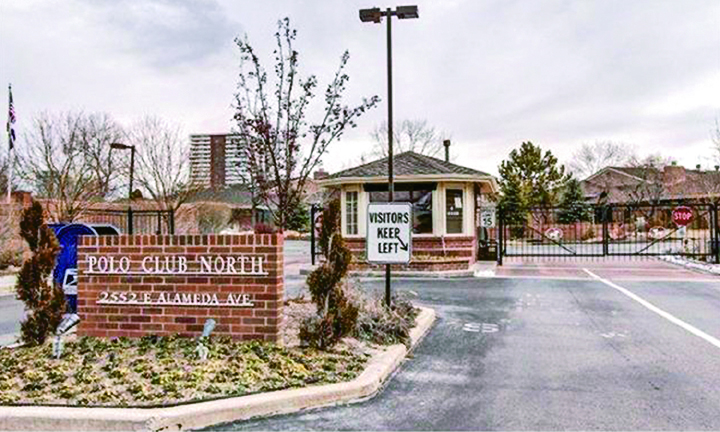
by Mark Smiley | Sep 29, 2014 | Main Articles
$500 Fine For Cars On Driveway Overnight
by Glen Richardson

Polo Club North is a gated community with winding streets, open spaces with a stream, small ponds and waterfalls flanked by evergreens and aspens at South University Boulevard and East Alameda Avenue. A clubhouse contains an indoor swimming pool and outdoor tennis courts. Polo ponies cantered over the terrain here at one time. Owners paid immense sums to have garages instead of stables in this converted polo field. But the subject of automobiles has the well-to-do neighbors at each others throats with threats of lawsuits in the air.
The HOA Rules Committee in Polo Club North has proposed an astonishing new rule: To ban resident cars from being left in driveways overnight. The Committee attached a fine of $500 per violation after the second night. The HOA board looked poised to adopt the rule at a board meeting on September 23. However, due to outrage from occupants, the package of proposed rules changes was returned to the Rules Committee for additional deliberation.
John Leather who is helping to lead the opposition told the Chronicle, “If the sample of public opinion delivered at the meeting meant anything to the Rules Committee members present, they will drop the enforceable structure.” In addition to potentially major penalties, owners also worry that the rule would impair the marketing of Polo Club North homes to families, especially those with three cars. According to the Denver Neighborhood News the average sales price of a home in Polo Club area is just under $1.9 million.
Property Rights
In the apparent opinion of the members of the Rules Committee automobiles in driveways are a visual blight to their community. Automobiles are not allowed to be parked overnight on the private roads of Polo Club North. The opposition believes that the Rules Committee’s view of aesthetics is excessive and overblown with one irate homeowner blasting the Board declaring, “We are a community, not a commune.” Moreover, opposition owners believe these pad plazas or driveways are their property; and use of a driveway is a property right.
Upshot: In their view taking away the use of the driveway is taking away property. That, they argue would violate the Colorado Constitution. The HOA Rules Committee has three Colorado lawyers among its seven members, however, and apparently finds no role or weight for Section 14 of the Colorado Constitution’s Bill of Rights as it applies to private condemnation of a property’s use and benefit.
Section 14 states: “Private property shall not be taken for private use unless by consent of the owner, except for private ways of necessity, and except for reservoirs, drains, flumes or ditches on or across the lands of others, for agricultural, mining, milling, domestic or sanitary purposes.” None of those constitutional exceptions apply to the driveway ban, opponents believe.
Whether or not the constitutional exceptions apply, concerned neighbors note that a resident with a two-car garage — most everyone — but with three cars would immediately be impacted, and they will have to run fast from the $500 nightly hit. Ditto anyone with a vehicle too big to fit in the garage, or who has two cars but has used one bay of the garage for a workshop or other use. As one homeowner told the Chronicle, “The driveway use restriction can no more be justified than telling me I cannot use my patio after 9 p.m. Where is the HOA’s authority for taking part of either limited common element?”
Matter Of Beauty
A few residents — and rumor has it that at least one Board member — believe the Committee should consider restricted driveway use as a matter of “beautifying” the community, similar to use of no-plastic-patio-furniture. These beautification proponents say all aspects of driveway parking personally offend them.
“Thus far the Rules Committee is also clinging to the notion an overnight resident parking ban is without legal significance, and entirely defensible because its members think the result will look better,” stated opposition leader Leather.
The opposition also blasted the HOA board for limiting the hearing on the entire matter to only 15 minutes. They claim it was a rush to judgment to prevent discussion and debate.
There is no date set by the HOA Board for a re-hearing on the matter.
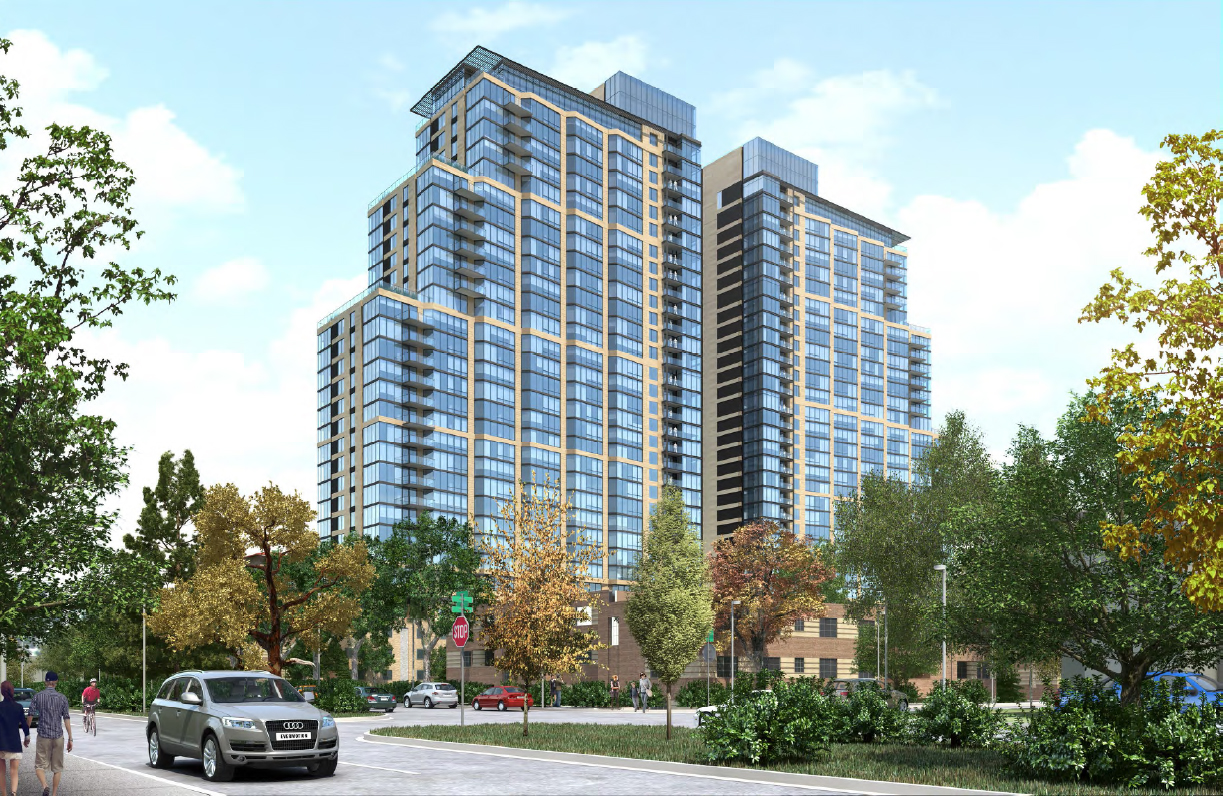
by Mark Smiley | Aug 29, 2014 | Main Articles
Construction Of Towers Into Historic Six-Acre Site Seen By Activists As Giving Area And Denver Another Black Eye
by Glen Richardson
Country Club Gardens — the historic 1940s five-building three-story apartment complex located in a six-acre landscaped garden environment adjacent to the Downing Street Parkway — is about to get hit with a pair of huge apartment houses as densification of the Cherry Creek and Country Club areas continues on unabated. The Broe Group is demolishing two existing garden apartments and replacing them with two overwhelming 30-story towers near the intersection of Downing St. and Ellsworth Ave.
The twin skyscrapers will be the tallest buildings outside of downtown Denver and will be equal in height to the One Tower Center on 17th Street, the 15th tallest building in Denver. By comparison, Plaza Tower One — one of the tallest towers in the Denver Tech Center — is only a 22-story building. The two towers will contain a total of 533 apart ment units and several floors of structured parking. The two buildings will be mirror images of one another and top out at 322 feet in height.
ment units and several floors of structured parking. The two buildings will be mirror images of one another and top out at 322 feet in height.
The two towers, along with the existing 22 story building at 1001 East Bayaud also constructed by Broe, will block the view of the mountains for much of the Cherry Creek area.
The latest plan is in response to a hostile historic designation effort undertaken in 2007. In response to those hearings Broe agreed to retain the three northern buildings at the Gardens in exchange for the right to build out the balance of the site. Area residents however are not pleased or content with the recent Landmark Planning Commission (LPC) decision to approve the two massive residential towers. They tell the Chronicle that the development-oriented Broe Group has been jabbing away at their neighborhood icon for 20 years and the proposed massive two-tower complex represents the k nockout punch.
nockout punch.
Residents Up In Arms
How will the twin skyscrapers impact the unique character of this celebrated neighborhood? “It will be devastating to the historic significance, charm and personality of Country Club Gardens,” said Karen Mansfield. “No one likes to have dark circles under their eyes but we’re like the kid that got hit with a shiner and we are fully expecting to have two black eyes soon.” The tower design, they say, tries to put the historic area on a pedestal with a snooty, rock star look. “We’ve been hit with a catchy hook that’s simply not a good look,” said Mansfield.
Kristian Jeichler noted to the Chronicle, “This is going to drastically change the Denver skyline and life in the Cherry Creek area.” The concern is that the two buildings will indelibly alter many Cherry Creek neighborhoods for better or for worse, depending on the perspective. Residents make the case that the towers take the trajectory of the historic area in a direction that falls short. “They will forever change the Valley skyline while damaging the unique layout of the buildings, internal courtyards and connecting open space within the Gardens,” said Jonathan Pierson.
Along with concerns about the mass and scale of the towers, the Landmark Planning Commission has also expressed unease about the project’s impact on the historic courtyards and landscaping. “Preservation and compatible development of the landscape and courtyard are critical to retaining the character of Country Club Gardens,” according to the LPC report. The commission is waiting on a pending arborist report. The LPC is also providing a design review over the demolition and construction activity directly related to the project outside of the boundaries of the Country Club Gardens Historic District. This includes improvements off of Bayaud St. adjacent to the historic landmark Norman site.
Broe’s Reputation
Over the years, Developer Pat Broe has garnered a reputation as a ruthless tough negotiator who is personally despised by many people but admired for his ability to make money. Don Elliman, the former director of the Colorado Office of Economic Development and International Trade, described Broe as “a complex guy who rubs some people the wrong way…” While Tom Clark, when he was executive vice president of the Metro Denver Economic Development Corp., declared, “We counsel our clients that they will not face a more challenging negotiation than they will with the Broe company.”
When asked whether he would even do business with Broe, Elliman said he would, “But I’d have my hand on my wallet and I’d have a damn good lawyer with me.”
Excavation Impact
The fight isn’t entirely over yet, Cherry Creek Garden activists say, noting that the Landmark Planning Commission’s recommendation for approval comes with conditions. The LPC report says the mass and scale must be consistent with the development agreement and the axial views and open space preserved and reinforced. Furthermore, approval is conditional on new plantings respecting and reinforcing historic patterns. Additionally, parking is required to be screened on all sides and integrated into massing of the new structures. Few believe that any of those requirements has the possibility of derailing the project.
The Broe Group will begin work this fall to raze the parking garage and portions of two of the apartment buildings where the twin towers are to be built. Construction of the towers themselves is set to begin in early 2015, with completion in late 2016.
When questioned about the impact of construction on people living in the Cherry Creek Gardens area, a spokesman for Broe told neighborhood groups that during peak excavation a dump truck would be coming or going from the project site approximately every 10 minutes. The spokesperson added that construction staging and other activities would be performed away from the site to limit disturbance. Also workers are to be bused to the area to reduce the congestion of trucks and other vehicles within the immediate area.
What Of Historic Significance Is Being Destroyed?
Constructed in 1940, Country Club Gardens was an excellent example of the International Style exemplified by the overall horizontality of the composition. Fisher, Fisher and Hubbell Architects — a leading Denver firm at the time — designed the buildings. The firm’s principals were Arthur Addison Fisher (1878-1965), his nephew Alan Berney Fisher (1905-1978), and Edward L. Hubbell. Nicholas G. Petry (1883-1950) was responsible for construction. He came to Denver in 1921 after building the Frontier Hotel in Cheyenne. Petry built many Valley buildings including Sherman Tower, the University of Denver apartments, and several Fitzsimons Hospital and Buckley Field buildings. With both residents and passersby in mind landscape architect M. Walter Pesman planned the landscaping with meticulous detail.
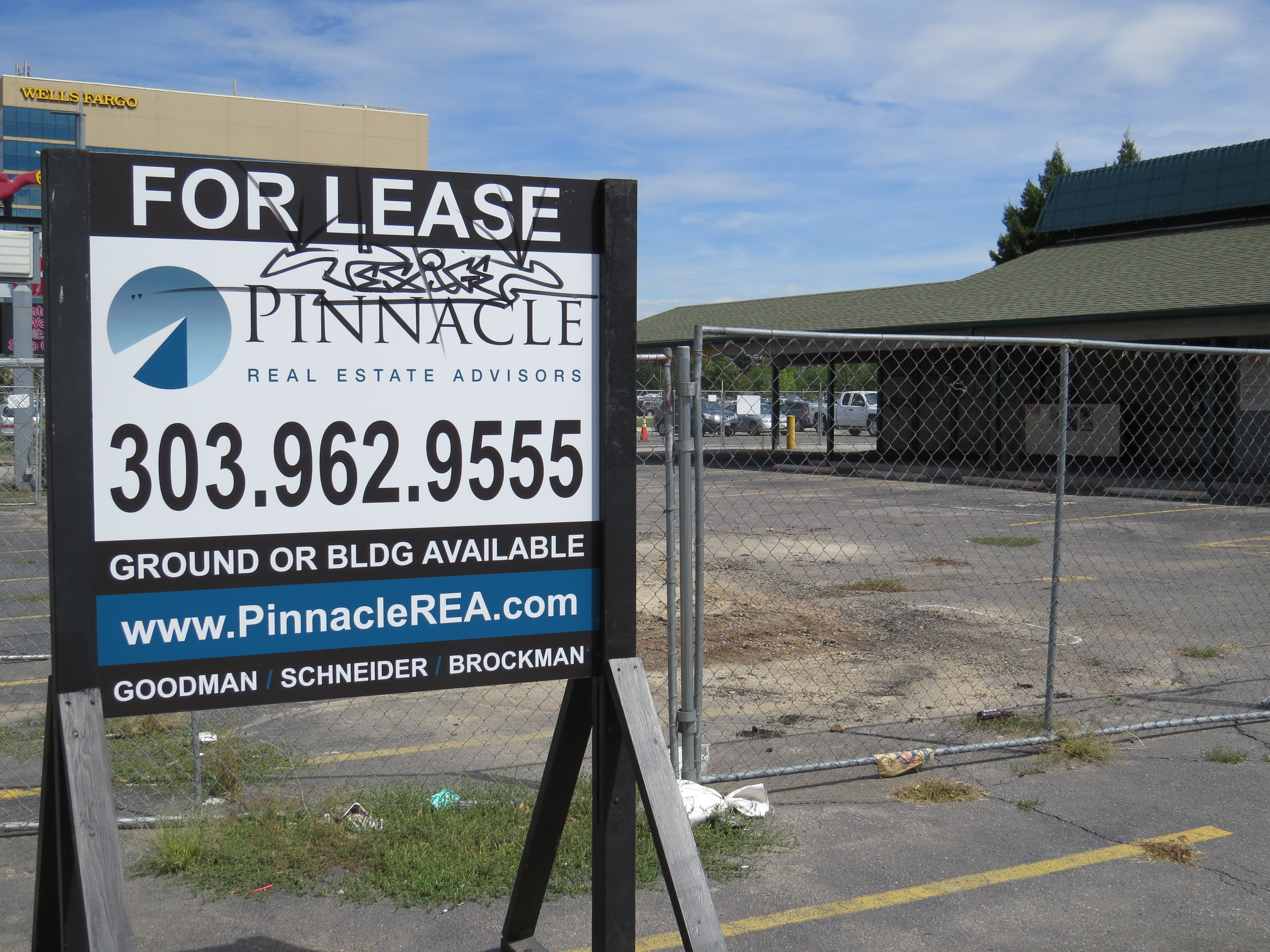
by Mark Smiley | Aug 29, 2014 | Main Articles
Complaints Flood City
The low slung masonry building at the corner of East Virginia Avenue and South Colorado Boulevard has been a Glendale landmark for over a half century, originally housing Club Monaco, and later such iconic businesses as Andy’s Smorgasbord, the Bavarian Inn, and, since 1982, Shotgun Willie’s adult nightclub. Today, however, the abandoned and graffitied building is an eyesore which has drawn complaints from businesses up and down Colorado Boulevard as well as residents of Glendale and Denver.
In November 2013, Shotgun Willie’s moved out of the building to the adjoining lot on which it had constructed its own new building. The City of Glendale condemned a portion of the land to provide a right turn lane due to the increased traffic generated by the adjoining Super Target. The old Shotgun Willie’s building and lot is owned by the Anthony Marino Family Trust.
After complaints at City Council meetings, the City threatened the Family Trust that it would declare the property a nuisance and tear down the building itself and bill the Family Trust its “applicable share.”
On August 15, however, Glendale and the Family Trust entered into a formal agreement whereby the City of Glendale granted a temporary construction easement for two months and will pay $10,000 toward the demolition of the building by Dave Stefanich, Inc. d/b/a All Demolition Excavating Company, a contractor of the Family Trust.
While the agreement does not mandate the demolition by any certain date, the two-month temporary easement would appear to require the destruction of the building by no later than October 15, 2014.
Marcus Rice, who went to a Glendale City Council meeting to complain about the abandoned building stated, “It is good news that building will be coming down in the near future. Glendale is turning into such a great place but the property was hurting the image of Glendale as well as that of Colorado Boulevard.”
Debbie Mathews, the majority owner of Shotgun Willie’s, noted, “We loved that old building while we were a tenant for decades but nobody is happier to find out that the City and the Anthony Marino Family Trust have come to an agreement to clean up the corner which our new building is directly behind. Sounds like a win-win for everyone involved.”

 For families living in the Virginia Vale and Hilltop neighborhoods it’s a nightmarish flashback to a development scheme that dates back more than 50 years. It involves a three-acre plot of land along Leetsdale Drive directly across the street from George Washington High School where developer Paul Naftel of Emerald Properties LLC is now proposing a Jimmy John’s be built where years earlier he proposed a McDonald’s.
For families living in the Virginia Vale and Hilltop neighborhoods it’s a nightmarish flashback to a development scheme that dates back more than 50 years. It involves a three-acre plot of land along Leetsdale Drive directly across the street from George Washington High School where developer Paul Naftel of Emerald Properties LLC is now proposing a Jimmy John’s be built where years earlier he proposed a McDonald’s.







 nockout punch.
nockout punch.